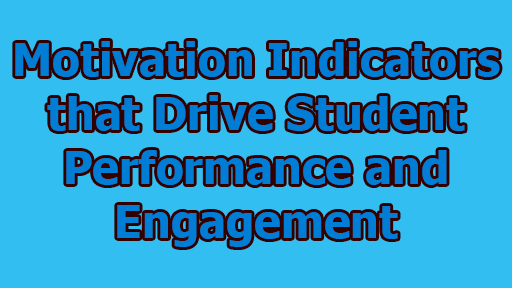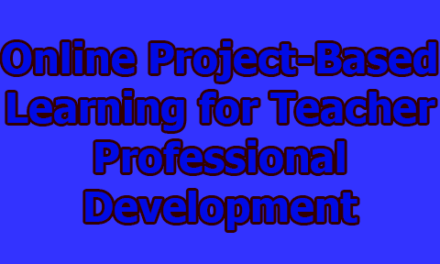Motivation Indicators that Drive Student Performance and Engagement:
Motivation is a crucial factor that influences a student’s performance, engagement, and overall academic success. It plays a pivotal role in determining the level of effort and persistence students invest in their studies. When students are motivated, they are more likely to believe in their abilities, take ownership of their actions, find value in their tasks, and seek social rewards, recognition, or a sense of belonging. In this article, we will delve into the various motivation indicators that drive student performance and engagement. By understanding these indicators, educators, parents, and policymakers can foster an environment that encourages and sustains students’ motivation, leading to improved learning outcomes.
Section 1: Belief in One’s Ability to Succeed: A student’s belief in their ability to succeed, known as self-efficacy, plays a fundamental role in shaping their motivation and academic performance. Self-efficacy refers to an individual’s confidence in their capabilities to organize and execute the necessary actions to achieve a specific goal. When students possess high self-efficacy, they are more likely to approach challenging tasks with determination and perseverance, viewing obstacles as surmountable rather than insurmountable.
Several factors contribute to the development of self-efficacy in students. First and foremost, past achievements and successes significantly impact their self-perception. Positive experiences, such as earning high grades, receiving praise for their efforts, or mastering complex topics, can bolster a student’s belief in their academic abilities. On the other hand, repeated failures or a lack of support can lead to decreased self-efficacy and reduced motivation to excel in school.
Teachers and peers also play a crucial role in shaping students’ self-efficacy beliefs. Positive reinforcement and constructive feedback from teachers can help students recognize their progress and build confidence. Teachers can foster a growth mindset, emphasizing that intelligence and abilities can be developed through effort and dedication, rather than being fixed traits. Additionally, observing peers who demonstrate effective learning strategies and succeed academically can serve as role models and inspire students to believe in their own abilities.
Educators can enhance self-efficacy by providing achievable challenges that stretch students’ capabilities without overwhelming them. By breaking down complex tasks into smaller, manageable steps and scaffolding learning experiences, teachers can instill a sense of accomplishment and competence in their students.
Section 2: The Link between Actions and Outcomes: The perception of a direct link between actions and outcomes is a crucial aspect of motivation. When students can clearly see the connection between their efforts and the results they desire, they are more likely to stay engaged and committed to their studies. A sense of control over their academic success empowers students to take ownership of their learning journey.
Feedback and assessment practices play a pivotal role in shaping students’ understanding of their progress and the link between effort and success. Effective feedback should be timely, specific, and constructive. It should focus not only on the final outcome but also on the process and effort invested by the student. By providing feedback that highlights their strengths and areas for improvement, educators can guide students toward productive learning behaviors.
Formative assessments, which provide ongoing feedback during the learning process, can be particularly impactful. These assessments allow students to track their progress and identify areas that require additional attention. As a result, students can adjust their learning strategies and study habits accordingly, reinforcing the link between effort and academic achievement.
Furthermore, goal-setting plays a significant role in emphasizing the connection between actions and outcomes. By involving students in setting realistic and achievable goals, educators encourage them to take an active role in their learning. Progress towards these goals becomes a visible measure of success, motivating students to persevere and strive for continuous improvement.
Section 3: Recognizing the Value of Tasks: Intrinsic motivation, rooted in an individual’s inherent interest or recognition of the value of a task, is a powerful driver of engagement and learning. When students find meaning and purpose in their studies, they become enthusiastic learners, eager to explore subjects beyond the confines of the classroom.
Educators can foster intrinsic motivation by creating a learning environment that nurtures curiosity and autonomy. Allowing students to have some choice in their learning, such as selecting topics for projects or engaging in inquiry-based learning, empowers them to take ownership of their education. When students have a say in their learning path, they are more likely to invest themselves fully in the process.
Integrating real-world applications and connecting the curriculum to students’ lives can also enhance intrinsic motivation. When students understand how academic concepts relate to their daily experiences and future aspirations, they are more likely to value the knowledge they gain in the classroom.
Furthermore, educators can promote intrinsic motivation by encouraging a growth mindset. Emphasizing that intelligence and abilities can be developed through effort and dedication helps students view challenges as opportunities for growth rather than insurmountable obstacles. This mindset fosters a love for learning and a willingness to embrace new challenges.
Section 4: Social Rewards, Recognition, and Sense of Belonging: Social interactions and a sense of belonging are essential aspects of student motivation. Positive relationships with peers, teachers, and the broader school community can significantly impact a student’s engagement and emotional well-being.
Peer relationships play a crucial role in shaping students’ attitudes toward learning. Collaborative learning environments, group projects, and classroom discussions provide opportunities for students to share ideas, support each other, and learn from one another. When students feel valued and respected by their peers, they are more likely to be motivated to actively participate in the learning process.
The role of teachers in creating a supportive and encouraging classroom climate cannot be overstated. A positive teacher-student relationship characterized by trust, empathy, and open communication fosters a safe space for students to take risks, make mistakes, and grow academically and emotionally. Teachers who express genuine interest in their student’s well-being and progress can inspire a strong sense of belonging and motivation to succeed.
Beyond the classroom, involvement in extracurricular activities and school clubs can provide students with a sense of community and belonging. Engaging in sports, arts, or academic clubs allows students to pursue their interests and passions outside of regular academics, contributing to their overall well-rounded development.
However, it is essential to strike a balance when using external rewards and recognition to motivate students. While praise and acknowledgment can be effective in boosting confidence and self-esteem, excessive use of external rewards, such as grades or prizes, may lead to a focus on extrinsic rather than intrinsic motivation. Therefore, educators must carefully consider when and how to provide recognition, ensuring that it does not undermine students’ intrinsic drive to learn.
In conclusion, motivation indicators play a pivotal role in shaping students’ academic journey and success. Belief in one’s ability to succeed, the perception of a direct link between actions and outcomes, recognition of the value of tasks, and the influence of social rewards and a sense of belonging all contribute to students’ engagement and enthusiasm for learning. As educators, parents, and policymakers, it is our collective responsibility to foster an environment that nurtures these indicators. By promoting self-belief, providing constructive feedback, encouraging intrinsic motivation, and cultivating positive social interactions, we can empower students to become enthusiastic and persistent learners. Understanding the multifaceted nature of motivation and applying effective strategies will not only lead to improved academic performance but also instill a lifelong love for learning and personal growth in our students, preparing them for a future filled with endless possibilities.
Reference:
Essa, A. (2016). A possible future for next-generation adaptive learning systems. Smart Learning Environments, 3(1), 16. https://doi.org/10.1186/s40561-016-0038-y

Former Student at Rajshahi University










